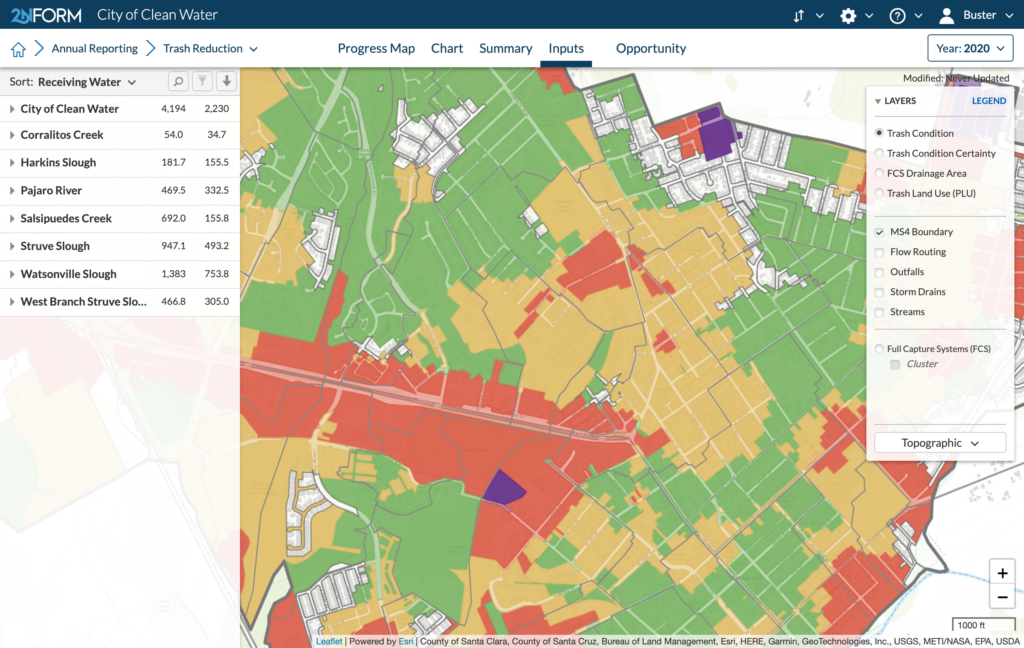Watsonville, CA has no full time stormwater staff, but Environmental Sustainability Division Manager Jackie McCloud still wants to keep her city and its waters clean — and comply with California’s ambitious Trash Amendments. Stormwater software 2NFORM is helping Watsonville clean up trash, maintain their structural assets, and comply with their MS4 permit. And they’ve recently used 2NFORM to help get $1.8 million in grants: that’s a big ROI.
THE CLIENT
City of Watsonville, CA
Environmental Sustainability Division Manager at City of Watsonville, Jackie McCloud
Watsonville, CA is adjacent to the Monterey Bay National Marine Sanctuary. It includes the protected Watsonville wetlands, freshwater sloughs that are home to diverse native wildlife and provide a stopping off point on the Pacific Flyway for migrating birds. Agriculture in the region produces strawberries, cauliflower, broccoli, lettuce, raspberries and more for export around the world, and provides the backbone of Watsonville’s economy.
THE CHALLENGE
No Dedicated Staff, No Dedicated Budget, No Time
Like many municipalities, Watsonville, CA doesn’t have dedicated stormwater funding or staff. Jackie McCloud, Environmental Sustainability Division Manager for the City of Watsonville, and her two full time team members are responsible for several city programs, and can give only a fraction of their hours to stormwater.
“Maintenance on our Structural BMPs fell really far behind,” Jackie says. Watsonville has only six public Structural BMPs (SBMPs), but having these assets in good working order is essential for removing trash and other pollutants and preventing flooding. Structural assets are big capital investments for any community, and are put in place after much thought and planning. But they can’t do their important work if they’re not properly maintained, and this is where many municipalities run into trouble, including Watsonville. Jackie had no way of knowing what condition Watsonville’s SBMPs were in or when they required maintenance without sending a member of her busy team to look. So maintenance fell behind, and the efficacy of these assets suffered.
Jackie is also working hard to clean up trash in Watsonville, both to make the community more pleasant for residents and to comply with California’s Trash Amendments, which have an ambitious goal of Zero Trash Down the Drain by 2030. But trash is notoriously difficult to manage. An attentive government employee, like Jackie, may intuit where trash collects in the community, but intuition is impossible to quantify and analyze. To comply with the Trash Amendments, she needs to prove that Watsonville is reducing the trash going into local receiving waters.
OUR SOLUTION
Jackie was intrigued when her then water quality regulator, Dominic Roques, suggested she try out some new stormwater software, called 2NFORM. 2NFORM is a robust software platform that provides intelligent stormwater management and compliance, purpose-built by stormwater scientists and experts to meet the needs of busy MS4 permit holders.
With Jackie on board, Dominic funded a pilot for Watsonville — and other communities on the Central Coast — to try out 2NFORM. Two years later, when the pilot ended, Jackie became a regular customer, because the software saves her team so much time and effort, solves their major stormwater problems, and is helping them organize pilots and get substantial grants.
Jackie sees a clear return on Watsonville’s investment in 2NFORM — and at budget time, she even uses 2NFORM to show her Public Works director how substantial that ROI really is. “With 2NFORM, it’s really easy to home in on where to focus money,” Jackie says.
Save Time, Save Effort, Get Grants
With 2NFORM, “We save cumulatively at least 80 hours over a quarter during the dry season,” Jackie says. This is a huge win for a small team with many competing priorities. It also allows Jackie to put that time toward other needs.
The interactive maps in 2NFORM make data much easier to interpret than looking at columns of numbers. “It’s really useful to see that spatial data light up,” Jackie says. “I don’t have to think about it very much. I’m so busy, so that’s incredibly useful for me.”
Jackie uses some of her time savings to apply for grants, and 2NFORM makes her applications both easy and compelling. “So far I’ve applied for three grants and gotten them all,” Jackie says proudly. She should be proud: those grants total almost $1.8 million, and all of it will “allow me to do more to protect water quality,” Jackie says.
Well Maintained Structural Stormwater Assets
2NFORM is organized into modules. Foundational modules handle information management and reporting on the six minimum control measures required by most MS4 permits. Additional modules empower stormwater managers with advanced analytics and planning capabilities, using the data collected for compliance to drive actual improvements in water quality. The Structural BMP module lets users like Jackie see all of their structural stormwater assets on an interactive map, including the asset type, how well it is currently performing, and when it will require maintenance.
“Regularly scheduling Structural BMP maintenance really helps,” Jackie says. The built-in analytics in 2NFORM, based on peer-reviewed science, mean that Jackie can create a maintenance schedule and prioritize needs, which is crucial for a small, busy team. “It’s so much more efficient, not having to always go and field inspect our SBMPs.”
Verifiable Trash Reduction with 2NFORM
The Trash module in 2NFORM quantifies where trash accumulates in a community, so Jackie doesn’t have to rely on intuition, but can use verifiable data to map trash quantities, from very high to low.

This is essential for compliance with California’s Trash Amendments, which require every MS4 permit holder to provide verifiable data that shows trash reduction. Structural assets treat parts of Watsonville, but the city has chosen Track 2 for managing their trash compliance, so they need to demonstrate that they’re using non-structural strategies to achieve “trash full capture equivalency.” The 2NFORM Trash module lets Jackie plan and track their trash capture efforts, and comply with this challenging new requirement.
With the trash status of her city quantified and mapped, Jackie can test out trash reduction strategies. She recently ran a six-month pilot study on trash reduction. Guided by 2NFORM, the team taught members of one “high trash” neighborhood to do trash assessments and reports, and gave them trash picker-uppers and buckets. An intern was trained to input the data into 2NFORM.
This pilot will “eventually become a model” for handling trash across Watsonville, Jackie says. She gleaned some useful learnings even from this brief pilot. The city will provide an additional public trash receptacle for the neighborhood and move existing trash cans away from storm drains. Based on the data, Jackie can hypothesize that these small actions will make a measurable difference — and she’ll be able to see if she’s right by watching the data over time.
People in the pilot neighborhood “loved being environmental warriors,” Jackies says. “They’re picking up trash and helping out with neighborhood beautification.” This is a huge success for both trash cleanup and public education and outreach, a double win, driven by data.
A Quantifiable Return on Investment
City governments are always strapped for cash, and must choose their investments wisely. Many, like Watsonville, are cautiously exploring the digital transformation that is changing the way business is done in this age of technological miracles. Utilizing software that provides a clear return on investment is a time-consuming chore in itself.
2NFORM truly does pay for itself, by saving time, saving work, making work more efficient and effective, making communication about that work clearer and more compelling — and in making grant applications both easier and more successful. And it delivers on the most important ROI of all for stormwater software: it helps us make the water cleaner.


